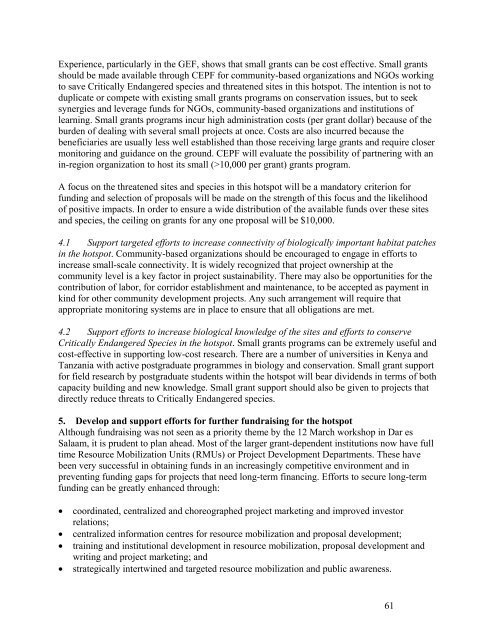Eastern Arc Mountains and Coastal Forests of Tanzania and Kenya ...
Eastern Arc Mountains and Coastal Forests of Tanzania and Kenya ...
Eastern Arc Mountains and Coastal Forests of Tanzania and Kenya ...
You also want an ePaper? Increase the reach of your titles
YUMPU automatically turns print PDFs into web optimized ePapers that Google loves.
Experience, particularly in the GEF, shows that small grants can be cost effective. Small grantsshould be made available through CEPF for community-based organizations <strong>and</strong> NGOs workingto save Critically Endangered species <strong>and</strong> threatened sites in this hotspot. The intention is not toduplicate or compete with existing small grants programs on conservation issues, but to seeksynergies <strong>and</strong> leverage funds for NGOs, community-based organizations <strong>and</strong> institutions <strong>of</strong>learning. Small grants programs incur high administration costs (per grant dollar) because <strong>of</strong> theburden <strong>of</strong> dealing with several small projects at once. Costs are also incurred because thebeneficiaries are usually less well established than those receiving large grants <strong>and</strong> require closermonitoring <strong>and</strong> guidance on the ground. CEPF will evaluate the possibility <strong>of</strong> partnering with anin-region organization to host its small (>10,000 per grant) grants program.A focus on the threatened sites <strong>and</strong> species in this hotspot will be a m<strong>and</strong>atory criterion forfunding <strong>and</strong> selection <strong>of</strong> proposals will be made on the strength <strong>of</strong> this focus <strong>and</strong> the likelihood<strong>of</strong> positive impacts. In order to ensure a wide distribution <strong>of</strong> the available funds over these sites<strong>and</strong> species, the ceiling on grants for any one proposal will be $10,000.4.1 Support targeted efforts to increase connectivity <strong>of</strong> biologically important habitat patchesin the hotspot. Community-based organizations should be encouraged to engage in efforts toincrease small-scale connectivity. It is widely recognized that project ownership at thecommunity level is a key factor in project sustainability. There may also be opportunities for thecontribution <strong>of</strong> labor, for corridor establishment <strong>and</strong> maintenance, to be accepted as payment inkind for other community development projects. Any such arrangement will require thatappropriate monitoring systems are in place to ensure that all obligations are met.4.2 Support efforts to increase biological knowledge <strong>of</strong> the sites <strong>and</strong> efforts to conserveCritically Endangered Species in the hotspot. Small grants programs can be extremely useful <strong>and</strong>cost-effective in supporting low-cost research. There are a number <strong>of</strong> universities in <strong>Kenya</strong> <strong>and</strong><strong>Tanzania</strong> with active postgraduate programmes in biology <strong>and</strong> conservation. Small grant supportfor field research by postgraduate students within the hotspot will bear dividends in terms <strong>of</strong> bothcapacity building <strong>and</strong> new knowledge. Small grant support should also be given to projects thatdirectly reduce threats to Critically Endangered species.5. Develop <strong>and</strong> support efforts for further fundraising for the hotspotAlthough fundraising was not seen as a priority theme by the 12 March workshop in Dar esSalaam, it is prudent to plan ahead. Most <strong>of</strong> the larger grant-dependent institutions now have fulltime Resource Mobilization Units (RMUs) or Project Development Departments. These havebeen very successful in obtaining funds in an increasingly competitive environment <strong>and</strong> inpreventing funding gaps for projects that need long-term financing. Efforts to secure long-termfunding can be greatly enhanced through:• coordinated, centralized <strong>and</strong> choreographed project marketing <strong>and</strong> improved investorrelations;• centralized information centres for resource mobilization <strong>and</strong> proposal development;• training <strong>and</strong> institutional development in resource mobilization, proposal development <strong>and</strong>writing <strong>and</strong> project marketing; <strong>and</strong>• strategically intertwined <strong>and</strong> targeted resource mobilization <strong>and</strong> public awareness.61
















